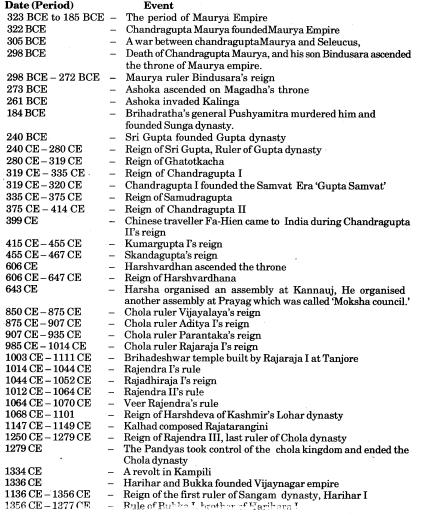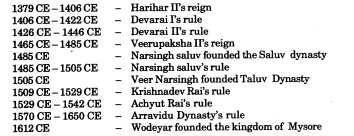Rajasthan Board RBSE Class 12 History Notes Chapter 2 The Golden Chapter of Indian History
Maurya Empire (323 BC-185 BC):
- India’s history finds itself on solid ground with the founding of the Maurya empire,
- Chandragupta Mauiya defeated the last Nanda ruler, Ghananand with the help and guidance of his mentor Chanakya (Vishnugupta or Kautilya) in 322 BC.
- A battle was faught between seleucus, the ruler of Macedonia, and Chandragupta, in which seleucus was defeated.
- Chandragupta Maurya followed Jainism under the guidance of Jain Muni Bhadrabahu.
- Chandragupta Maurya’s son Bindusara ascended the throne of the empire in 298 BCE.
- Ashoka was named ‘Devanampriya’, ‘Devanapriyadarshi’.
- Ashoka founded a city named ‘Srinagar’ on the bank of Vitasta river and Lalitpattan city in Nepal.
- Ashoka gave the principle of welfare state and made public welfare the most important objective of his rule.
- Ashoka appointed Dhamma preachers and administrators.
- The king was the central power of the administrative system in the Mauiyan administration.
- A council of ministers played an advisory role in the Mauryan administration.
Gupta Empire (240 CE to 550 CE):
- Sri Gupta (240 CE – 280 CE) was the founder of the Gupta dynasty.
- The ‘Prayag Pillar’ inscription in Allahabad (UP) is an important historical source of the Gupta period.
- Chandragupta II is considered to be the greatest king in Indian history due to his valour and brave qualities.
- Chinese traveller Fa-hein came to India during Chandragupta IPs reign.
- Kumargupta I (415 CE – 455 CE) issued a large number of coins. About 623 coins were found in Bayana – Mudrabhand region.
- Probably the Gaurs of Bengal finally ended the Gupta empire.
- The summit of ancient India’s architecture, sculpture, painting etc. is observed in the Gupta period.
- Literature made astounding progress in the Gupta period.
- Nalanda was a major educatioal centre of India. Probably Gupta emperor Kumargupta I, got it constructed.
- Aryabhatta propounded the principles of earth’s spherical shape and its rot ation about its axis.
- Kanad rishi propounded ‘Vaisheshik Darshan’ and the theory of atom in the Gupta period.
- During Gupta period, Ujjain was the most important trading centre. Peshawar, Mathura, Paithan were the major trading and industrial centres.
- Gupta era is called the ‘Golden Age’ of ancient India.
India in Harsha’s Reign:
- After the disintegration of the Gupta empire, the Pushyabhuti dynasty was founded in Thaneswar of Haryana. In 606 CE, Harshvardhan became the ruler of Thaneswar and ruled till 647 CE.
- Harsha’s empire was based on feudal system. He exercised direct administrative control on his home state but had indirect control over all other states.
- One-fourth of Harsha’s revenue was spent on intellectual persuits.
- Heiun-Tsang was a Buddhist Chinese traveller who visited India during Harsha’s reign.
- In Harsha’s time, Indian culture was promoted in Tibet-China and other Asian countries. He sent a delegation to China.
Chola Dynasty:
- Urruvapphare Ilan Jait Chainni was the first ruler of Chola dynasty.
- Karaikal was the most important ruler among the early chola kings. This imperialist ruler defeated the joint armies of
- Valeri and eleven other rulers at Vanni and gained fame.
- Chola administration had a monarchial and dynastic form.
- The most significant feature of chola administration was local autonomy on the rural and urban levels.
kalhad’s Rajatarangini and History of Kashmir:
- Kalhana composed Rajatarangini during the reign of last Lohar dynasty ruler Jaisingh. The period of its composition is between 1147 CE to 1149 CE.
- Kalhad’s Rajatarangini is considered to be the first authentic treatise of history of India.
- The literal meaning of Rajatarangini is-the river of king—which implies the history of kings or passage of time.
- The most important thing about Kalhad was that he was very forthcoming and fearless in commenting upon contemporary issues.
The Rise of Vijayanagar Empire:
- The literal meaning of Vijayanagar is ‘City of Victory’.
- Generally, Vijayanagar city is considered to be the first Hindu empire of the medieval age.
- Vijayanagar empire was named after its capital located on the Southern banks of river Tungabhadra.
- Persian traveller, Abdur Razzak wrote that Vijayanagar was one of the world’s most glorious cities, which he had seen or heard about.
Sangam dynasty (1336 CE to 1486 CE):
- This dynasty was founded by Harihar I and Bukka.
- After Bukka’s death, his son Harihar II became the ruler who reigned from 1379 CE to 1406 CE. He assumed the titles of‘Maharajadhiraja’and ‘Rajaparmeshawara’.
- Persian ambassador Abdur Razzak came to Vijayanagar in Devarai II’s reign.
Saluv Dynasty (1485 CE – 1505 CE):
Narsingh Saluv founded this dynasty in 1485 CE.
Tuluv Dynasty (1505 CE to 1570 CE):
The dynasty founded by Veer Narsingh was called the Tuluv dynasty. The greatest king of this dynasty was Krishnadev Rai who reigned between 1509 CE to 1529 CE.
Arravidu Dynasty (1570 CE – 1650 CE):
- Rama Rai’s brother Tirumaal laid the foundation of Arravidu dynasty.
- In 1612, Wodeyar founded the kingdom of Mysore.
- The kingdom of Mysore existed for about 300 years. It contributed significantly towards the emergence of Hindu religion and culture in South India.
- Although the Vijayanagar rulers gave priority to Sanskrit and Telugu languages yet they gave patronage to poets of other languages too.
Important dates and the events mentioned in the chapter:


Important Vocabulary:
- Inscription — That which is written on a solid substance (pillars, coins, monument etc.) for preservation.
- Dhamma — It was propagated by Ashoka. It includes universally acceptable conduct and elements and moral values.
- Teertha — Senior most state officials in Mauryan empire.
- Nagrak — The head of city administration in Maurya empire.
- Gopa — Assisting officials of the head of city administration in Mauryan empire.
- Sthanik — Assisting officials of the head of city administration in Mauryan empire.
- Sanstha — Spies in Mauryan empire.
- Sanchaar — Spies is Mauryan empire.
- Rajuk — Main judicial officials during Mauryan empire.
- Vyavaharik — Main judicial officials in Mauryan empire.
- Shrenis — Trade and industry were organised in shrenis.
- Jayestha — The chief of a Shreni was called Jayestha.
- Nigam — A large institution than Shreni.
- Shresthi — The chief of Nigam.
- Sarthavaha — The leader of trade caravans.
- Bhag — l/6th part of crop production that went to the king.
- Bhoga — Tax given to the king in form of fruits, flowers.
- Hiranya — Taxes paid in cash.